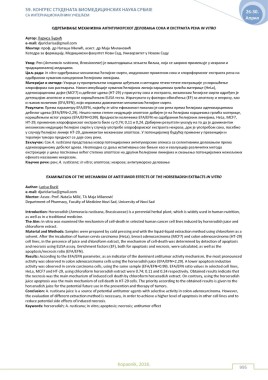Page 1001 - 59. КОНГРЕС СТУДЕНАТА БИОМЕДИЦИНСКИХ НАУКА СРБИЈЕ СА ИНТЕРНАЦИОНАЛНИМ УЧЕШЋЕМ
P. 1001
59. КОНГРЕС СТУДЕНАТА БИОМЕДИЦИНСКИХ НАУКА СРБИЈЕ 26-30.
СА ИНТЕРНАЦИОНАЛНИМ УЧЕШЋЕМ Април
ОДРЕЂИВАЊЕ МЕХАНИЗМА АНТИТУМОРСКОГ ДЕЛОВАЊА СОКА И ЕКСТРАКТА РЕНА IN VITRO
Аутор: Лариса Ђурић
e-mail: djuriclarisa@gmail.com
Ментор: проф. др Наташа Милић, асист. др Маја Милановић
Катедра за фармацију, Медицински факултет Нови Сад, Универзитет у Новом Саду
Увод: Рен (Armoracia rusticana, Brassicaceae) је вишегодишња зељаста биљка, која се широко примењује у исхрани и
традиционалној медицини.
Циљ рада: In vitro одређивање механизма ћелијске смрти, индуковане применом сока и хлороформског екстракта рена на
одабраним хуманим канцерским ћелијским линијама.
Материјал и методе: Узорци су припремљени хладним цеђењем и методом течно-течне екстракције уз коришћење
хлороформа као растварача. Након инкубације хуманих ћелијских линија карцинома грлића материце (HeLa),
аденокарцинома дојке (MCF7) и дебелог црева (HT-29) у присуству сока и екстракта, механизам ћелијске смрти одређен је
детекцијом апоптозе и некрозе коришћењем ELISA теста. Израчунати су фактори обогаћења (EF) за апоптозу и некрозу, као
и њихов количник (EFA/EFN), који изражава доминантан механизам ћелијске смрти.
Резултати: Према параметру EFA/EFN, највећу in vitro ефикасност показао је сок рена према ћелијама аденокарцинома
дебелог црева (EFA/EFN=2,29). Нешто нижи степен индукције апоптозе добијен је на ћелијама карцинома грлића материце,
коришћењем истог узорка (EFA/EFN=0,99). Вредности количника EFA/EFN на одабраним ћелијским линијама, HeLa, MCF7,
HT-29, применом хлороформског екстракта биле су 0,74; 0,11 и 0,24. Добијени резултати указују на то да је доминантан
механизам индукције ћелијске смрти у случају употребе хлороформског екстракта некроза, док је употребом сока, посебно
у случају ћелијске линије HT-29, доминантан механизам апоптоза. У потенцијалној будућој примени у превенцији и
терапији тумора предност се даје соку рена.
Закључак: Сок A. rusticana представља извор потенцијалних антитуморских агенаса са селективним деловањем према
аденокарциному дебелог црева. Неопходна су даља испитивања ове биљке као и евалуација различитих метода
екстракције у циљу постизања већег степена апоптозе на другим ћелијским линијама и смањења потенцијалних нежељених
ефеката изазваних некрозом.
Кључне речи: рен; A. rusticana; in vitro; апоптоза; некроза; антитуморско деловање
EXAMINATION OF THE MECHANISM OF ANTITUMOR EFFECTS OF THE HORSERADISH EXTRACTS IN VITRO
Author: Larisa Đurić
e-mail: djuriclarisa@gmail.com
Mentor: Assoc. Prof. Nataša Milić, TA Maja Milanović
Department of Pharmacy, Faculty of Medicine Novi Sad, University of Novi Sad
Introduction: Horseradish (Armoracia rusticana, Brassicaceae) is a perennial herbal plant, which is widely used in human nutrition,
as well as in a traditional medicine.
The Aim: In vitro was examined the mechanism of cell-death in selected human cancer cell lines induced by horseradish juice and
chloroform extract.
Material and Methods: Samples were prepared by cold pressing and with the liquid-liquid extraction method using chloroform as a
solvent. After the incubation of human cervix carcinoma (HeLa), breast adenocarcinoma (MCF7) and colon adenocarcinoma (HT-29)
cell lines, in the presence of juice and chloroform extract, the mechanism of cell-death was determined by detection of apoptosis
and necrosis using ELISA assay. Enrichment factors (EF), both for apoptosis and necrosis, were calculated, as well as the
apoptosis/necrosis ratio (EFA/EFN).
Results: According to the EFA/EFN parameter, as an indicator of the dominant antitumor activity mechanism, the most pronounced
activity was observed in colon adenocarcinoma cells using the horseradish juice (EFA/EFN=2.29). A lower apoptosis induction
activity was observed in cervix carcinoma cells, using the same sample (EFA/EFN=0.99). EFA/EFN ratio values in selected cell lines,
HeLa, MCF7 and HT-29, using chloroform horseradish extract were 0.74; 0.11 and 0.24 respectively. Obtained results indicate that
the necrosis was the main mechanism of induced cell death by chloroform horseradish extract. On contrary, using the horseradish
juice apoptosis was the main mechanism of cell death in HT-29 cells. The priority according to the obtained results is given to the
horseradish juice for the potential future use in the prevention and therapy of tumors.
Conclusion: A. rusticana juice is a source of potential antitumor agents with selective activity in colon adenocarcinoma. However,
the evaluation of different extraction method is necessary, in order to achieve a higher level of apoptosis in other cell lines and to
reduce potential side effects of induced necrosis.
Keywords: horseradish; A. rusticana; in vitro; apoptosis; necrosis; antitumor effect
Kopaonik, 2018.
995

